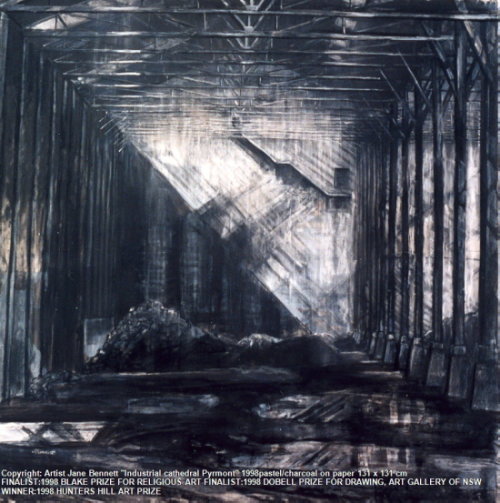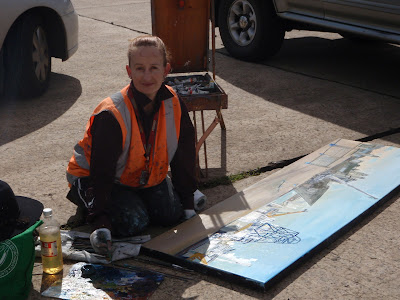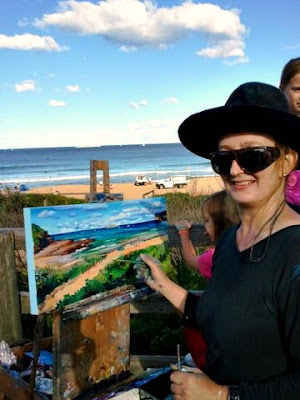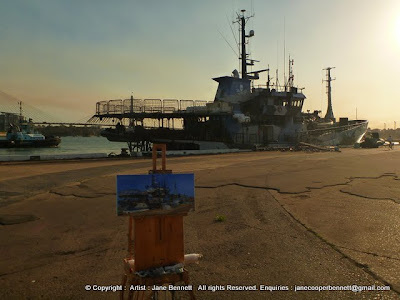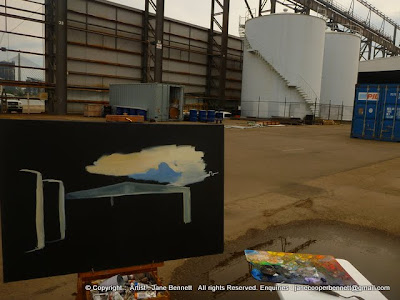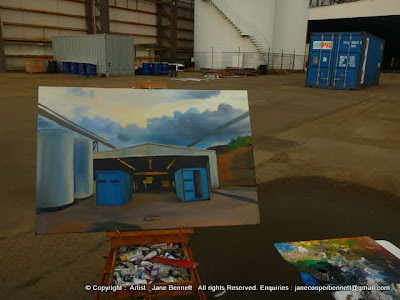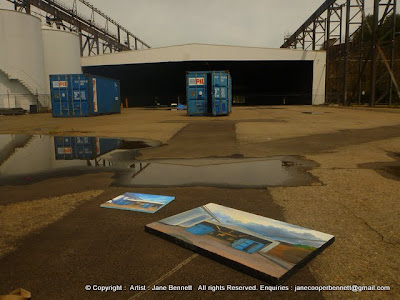I had run out of paper, so I took some free postcards from the bookshop to record my thoughts.

This is the other side of the postcard from the bookshop of the Musée National Picasso.
I used the back of these to draw on at first as an act of desperation - I had run out of art materials and money!
However, from that time on, whenever I visit an exhibition I now always use the catalogue or booklet from the gallery to record my thoughts about the exhibition. It gives the sketches some context, I can remember exactly what I have seen and where.
At school I had driven my teachers crazy by annotating my textbooks in a similar fashion whenever I was bored, which meant about 99% of every lesson. This turned out to be a good foundation for my future career rather than timewasting and daydreaming. Somewhere in a dusty school cupboard there might still exist a few of my "illustrated manuscripts".

My sketch of "Study for 'Les Desmoiselles D'Avignon' "
Pablo Picasso 1907
ink on card 18 x 13cm 1997
Available
During my Travelling Art Scholarship I filled page after page every day with annotated sketches of famous paintings and observations about my surroundings. Sometimes this was to learn some technique or to note some aspect of the painting for use later in one of my own paintings. Mostly it was just to make sure that I really looked at the works and didn't just skim over them. If I draw something I will remember what I have seen. If I've just taken a photo of something, I'll swiftly forget it. The greatest compliment you can pay to a work of art is to give it your time and attention.
I was interested in seeing the working sketches for iconic works such as 'Les Desmoiselles D'Avignon'- what was included; what was discarded - the paths not taken.The painting is now such an icon of modern art that it is easy to forget that its final form was not inevitable, but arrived at after months of struggle.

My ink drawing of
"Head of Marie-Therese Walter" Pablo Picasso, Boisgeloup 1932
ink on card 18 x 13cm 1997
Available

My drawing of "Le Viel Homme Assis" by Pablo Picasso
graphite on card 18 x 13cm 1997
Available

My drawing of
"Le Fou", a bronze sculpture by Pablo Picasso from 1905
graphite on card 18 x 13cm 1997
Available
This little bronze was also exhibited in the current exhibition at the Art Gallery of NSW "Picasso: masterpieces from the Musée National Picasso, Paris".

My ink drawing of one of Pablo Picasso's classically inspired heads.
ink on card 18 x 13cm 1997
Available
I love the Protean nature of Picasso's art - how he would switch from the restrained classical poise in this example to the wild energy and cartoonish violence of the next example without missing a beat.

My gouache and ink drawing of
Pablo Picasso's Le baiser (The kiss) 1969, oil on canvas,
97 × 130 cm, and above it "Les Banderilla"
ink and gouache on card 18 x 13cm 1997
Available
This oil painting is also included in the current exhibition at the Art Gallery of NSW "Picasso: masterpieces from the Musée National Picasso, Paris".

My gouache and ink drawing of
Pablo Picasso's 1961 "Woman and child"
ink and gouache on card 18 x 13cm 1997
Available

My gouache and ink drawing of Pablo Picasso's
1961 project for a monument
"Femme aux bras ecartes"
ink and gouache on card 18 x 13cm 1997
Available

My gouache and ink drawing of
Pablo Picasso's"La Jeune Fille assise"
ink and gouache on card 18 x 13cm 1997
Available

My gouache and ink drawing of a faun by Pablo Picasso
ink and gouache on card 18 x 13cm 1997
Available

My gouache and ink painting of
"L'homme au mouton (Man with sheep)" Pablo Picasso, 1940s
ink and gouache on card 36 x 13cm 1997
Available
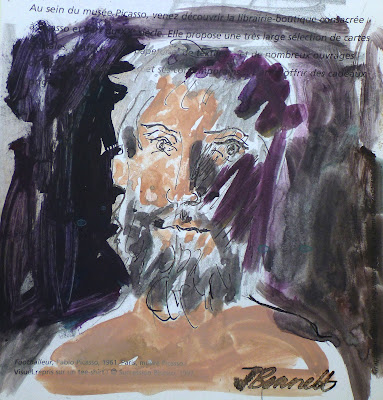
Close up detail of my gouache and ink painting of
"L'homme au mouton (Man with sheep)" Pablo Picasso, 1940s
ink and gouache on card 18 x 13cm 1997
Available
"Art washes away from the soul the dust of everyday life." (Pablo Picasso) I loved the gentle expression on the face of "L'homme au mouton (Man with sheep)" Pablo Picasso, 1940s. If I was having a difficult day, I would feel revived by looking at his calm and tender features.
"I paint the way someone bites his fingernails; for me, painting is a bad habit because I don't know nor can I do anything else." (Pablo Picasso)
In the very first week of my Travelling Art Scholarship, I had accidentally dropped my camera off a bridge in Rotterdam. It seemed like a disaster at first, but it turned out to be the best thing I could have ever done to hone my drawing skills, as it forced me to get faster and more decisive with my work or miss the moment entirely. My drawings were more interesting than my photos were anyway and I didn't bother replacing my camera until after I got back to Australia.
Another thing that initially seemed to be a disaster and turned out to be a blessing in disguise, was that I am completely useless at learning new languages. Despite my best efforts, my German is appalling, my French is pitiful and my Italian is worse. And according to the English, I don't speak English all that well either! If I wanted to make myself understood, I would have to draw whatever I needed. This would at least get a laugh, if nothing else. It worked a treat, and I had no problems with communication wherever I went. Art is truly a universal language.
It taught me that a work of art can have many purposes, from shallow to deep.
Related articles
(guardian.co.uk)
Related posts in this blog
Homage to Picasso Part 1
